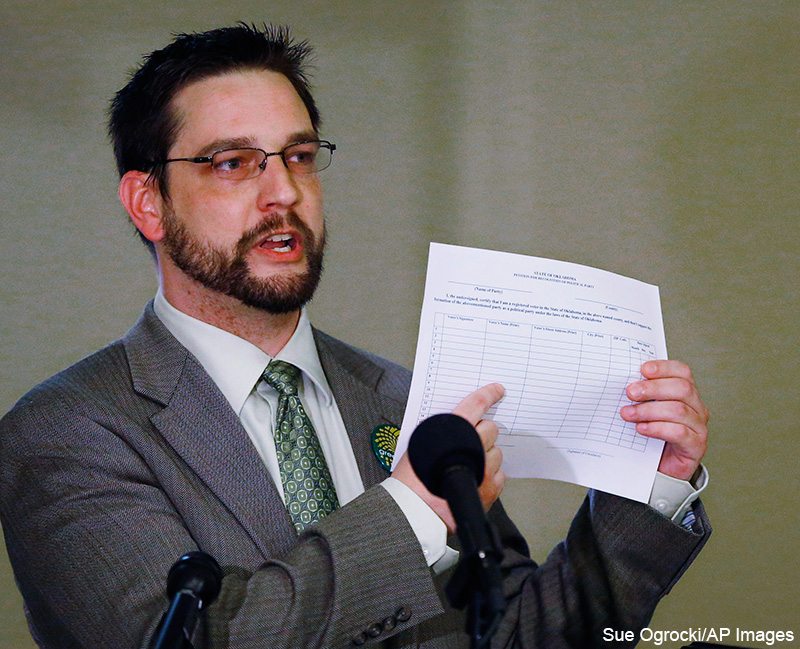
Credit: Sue Ogrocki/AP Images.
A Green Party representative for the group Oklahomans for Ballot Access Reform, displays a petition form to launch signature drives to have their parties and candidates officially recognized in Oklahoma.
A Closer Look at Third Parties
While the history of American politics has largely been a two-party system, the concept of an “alternative option” goes back a long way. Third parties tend to be either issue-focused or centered around a particular person.
A winner-take-all electoral process has kept most of these alternative political viewpoints from gaining considerable traction in any particular election. But the impact of these political parties can be measured in the adoption of particular platforms or the implementation into public policy. Here are a few of our country’s most significant Third Parties through history.
In 1845, a group of Protestant-born Northeasterners organized around a single issue, the insurgence of German and Irish Catholic immigrants into the United States. Members of this group called themselves “nativists” and were staunchly anti-immigration.
The “Know-Nothings” got its nickname because, when asked about the nature of their political organization, members were supposed to respond that they knew nothing. In the 1856 election, former President Millard Fillmore (1850–53) was its candidate and won 22% of the popular vote.
In the early 1900s, a man named Eugene Debs believed strongly in the fight against injustice and in closing the significant gap between the rich and poor. He ran for president as a Socialist five times between 1900 to 1920, even running from prison in 1920 as a write in. (He had been jailed for threatening national security after encouraging others to resist the draft.)
Ultimately, Debs’ ideas about graduated income tax, minimum wage, the direct election of senators, social security, worker’s compensation and women’s suffrage become part of public policy, but they were implemented by the other major political parties in the nation–and not accomplished as quickly as Debs would have liked.
Former president Theodore Roosevelt (1901–1909) of the Republican Party had a falling out with sitting Republican president William Taft over many issues. In response, Roosevelt sought another chance in the White House representing a new third party in 1912.
The Progressive Party was nicknamed the Bull Moose Party after Roosevelt told the press that he felt “fit as a bull moose” despite being shot on his way to give a speech. Opponent Woodrow Wilson ultimately won the election, but the Progressive Party gained more electoral support than Taft.
This is another example of a one-issue party, focused on the problem of segregation. Before the Civil War and well into the twentieth century the South was a strong supporter of the Democratic Party. Many Southerners still identified with the Confederates who fought the Civil War and believed in states rights (the preference of state governments over the national government to create policies).
This faction clashed with the values of the Democratic Party following the Great Depression and World War II, which focused on strengthening the protections of the New Deal and expanding individual rights.
For the 1968 election, former Alabama governor George Wallace ran as a third candidate on the American Independent ticket, ultimately losing to Republican nominee, Richard Nixon. However, political analysts consider it a major realigning election (one that causes a considerable shift in the political system).
One of the most successful third party candidates in recent history is H. Ross Perot. An active supporter of POW/MIA issues, this Texas billionaire was adamantly opposed to United States involvement in the Gulf War.
Perot announced his third party candidacy in the 1992 election. Perot won nearly 19% of the popular vote across the nation, but did not win any Electoral College votes. The United We Stand citizen action organization became the Reform Party in 1996.
This party is often seen as more fiscally conservative than Republicans and more culturally liberal than Democrats. The Libertarian Party shares characteristics with both. It believes in “liberty over government,” which means less government, in both civic as well as social issues. It is sometimes thought of as more of a philosophy than a political platform.
Libertarians favor the “sovereignty of the individual.” Former member of the House of Representative from Texas, Ron Paul ran as a Libertarian candidate in the 1988 election before running as Republican in 2008. Gary Johnson, former governor of New Mexico, is the current Libertarian nominee for the 2016 presidential election.
In 1996, the Association of State Green Parties (ASGP) was founded. In 2001, it became the Green Party of the United States (GPUS). There are “four pillars” that serve as the foundation of this party: Ecological Wisdom, Grassroots Democracy, Nonviolence, and Social Justice.
The Green Party does not accept donations from political action committees (PACs). Two of the party’s highest profile leaders are Ralph Nadar, who won nearly 3% of the popular vote in 2000, and 2012 candidate Jill Stein of Massachusetts. Stein is also running for president in the 2016 election.
Dig Deeper Pick one of the parties listed above that most appeals to you, or find another current but lesser known political party looking to take advantage of distaste with both Trump and Clinton. Do some research and list at least two interesting facts not already mentioned and write a few sentences.
Lia Eastep



![Library of Congress Prints and Photographs Division [LC-USZ62-90739]](https://mheelectioncentral.mheducation.com/wp-content/uploads/2016/08/080916_05P_IS-150x150.jpg)